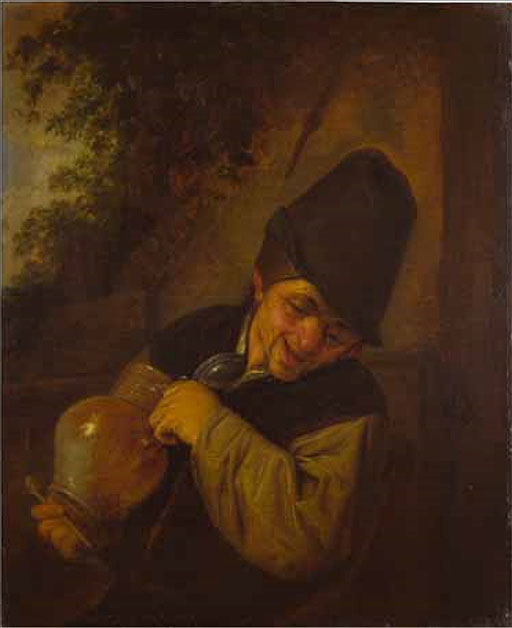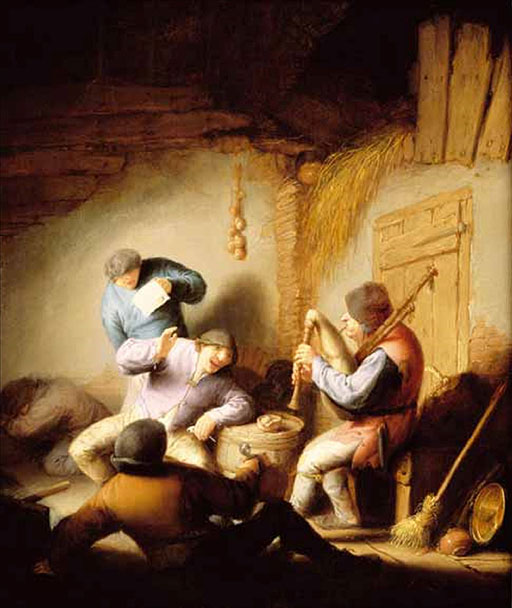2 Realism and art-for-art’s sake
From the late nineteenth century through to the mid twentieth century, it was widely accepted among art historians that Dutch painting of the golden age was distinguished from other national traditions by its realism. Thus, for example, the German art historian Wilhelm Bode, in his 1883 Studien zur Geschichte der holländischen Malerei (Studies in the History of Dutch Painting), declared: ‘It is evident that the fundamental tendency of this painting is above all realistic.’ (Bode, 1883) Realism here seems to have meant two different but closely related things. On the one hand, the term was used to describe the choice of subject matter taken from everyday life, such as domestic and tavern scenes, rather than classical or mythological subjects. Here realism is a matter of what is represented. On the other hand, the term was used to characterise a form of painting that purportedly offered a more truthful or exact imitation of visual appearances. Here realism serves to identify how an object or scene is represented (Białostocki, 1984). Although these two forms of realism frequently appear together, there is no necessary connection between them: it is possible to produce an idealised image of a street urchin (such as those painted by the seventeenth-century Spanish artist Murillo), just as it is possible to produce a realistic image of a king. However, the double meaning of the term allowed art historians to extend its use to accommodate a broad spectrum of Dutch paintings. The subject of ter Borch’s Boy Delousing a Dog (Figure 9) could not be further removed from the elaborate display of finery in his Curiosity (Figure 8), but the capacious term ‘realism’ allowed the one to be praised for its humble subject matter and the other for the verisimilitude, or truthfulness, with which the artist has rendered the textures of different fabrics and materials.
We have already seen that for Hegel the turn away from religious, historical and mythological subjects towards scenes of everyday life is closely allied to an interest in painting for its own sake – as if artists were liberated to pursue their own preoccupations by no longer having to depict weighty and important themes. This view is at variance with other conceptions of realism that took hold in the mid to late nineteenth century, which tended to emphasise the overriding importance of the artist’s social and political concerns and hence the incompatibility of realism with the notion of art-for-art’s sake. Despite the example of an artist like Courbet, whose work combines realism with political commitment, Hegel’s ideas seem to have struck a chord with Fromentin, who, if anything, provides an even more radical version of his argument. Fromentin contends that ‘the great Dutch school seemed to think of nothing but painting well’ and that it is characterised by ‘the total absence of what today we call a subject’ (Fromentin, E., 1948 [1876], p. 108). Here the term ‘subject’ doesn’t simply mean the painting’s depicted content but rather the moral, emotional or intellectual message that it is intended to convey. Fromentin is pointing up a contrast between the requirements of academic history painting, in which the artist was expected to depict noble and heroic individuals engaged in actions of emotional or intellectual significance, and the mundane and seemingly inconsequential incidents and events depicted in many Dutch paintings, among which he lists ‘drinking, smoking, dancing, kissing the maids’ (Fromentin, E., 1948 [1876], p. 112).
Fromentin contends that rather than looking for any deeper meaning we should recognise that these paintings are valuable first and foremost as art and that the quality of a painting is therefore independent of the subject that is represented:
What motive had a Dutch painter in painting a picture? None. And notice that he never asked for one. A peasant with a drunken red nose looks at you with his heavy eye and laughs with open mouth showing his teeth, raising a jug; if it is well painted, it has its value.
It is not clear whether Fromentin had any particular painting in mind when he wrote this passage, but it may be useful to consider it alongside a work by Adriaen van Ostade (Figure 10). Ostade (1610–85) specialised in the depiction of peasants drinking, merry-making and fighting, both out of doors and in dimly lit interiors (Figure 11). Despite a tendency towards caricature in the treatment of the figures, his work is characterised by subtle chiaroscuro effects and a remarkably delicate use of colour. Paintings such as these raise interesting questions about their intended audience and how they might have been viewed at the time. One possibility is that the intensive urbanisation of Dutch society created a market for images of rural life, including the imagined ‘freedoms’ that were permitted outside the more tightly regulated civic environment. However, it also seems likely that they catered to an urban disdain towards humble rural folk and thus served to reinforce the self-perception of city dwellers as more cultivated and sophisticated than those who lived in the countryside. This ambiguity is central to the significance of paintings of rural life in seventeenth-century Holland, which were largely purchased by those who had left this life behind.


